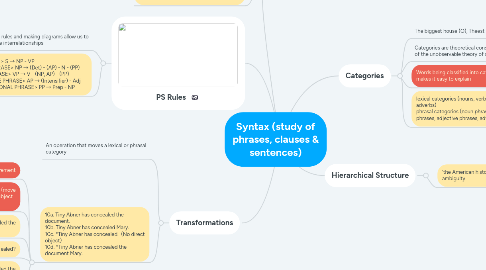Syntax (study of phrases, clauses & sentences)
by Hyunsong Lee


1. PS Rules
1.1. PS rules and making diagrams allow us to see interrelationships
1.2. <SENTENCE> S → NP - VP <NOUN PHRASE> NP → (Det) - (AP) - N - (PP) <VERB PHRASE> VP → V - (NP, AP) - (PP) <ADJECTIVE PHRASE> AP → (Intensifier) - Adj <PREPOSITIONAL PHRASE> PP → Prep - NP
2. Left-to-Right Ordering
2.1. The red car (O), Red the car (X)
2.2. The left-to-right sequence of items within a phrase is governed by principles that are codified in phrase structure (PS) rules.
3. Transformations
3.1. An operation that moves a lexical or phrasal category
3.2. 10a. Tiny Abner has concealed the document. 10b. Tiny Abner has concealed Mary. 10c. *Tiny Abner has concealed. (No direct object) 10d. *Tiny Abner has concealed the document Mary.
3.2.1. wh-movement
3.2.2. Inflection movement (I-movement) (move the tensed verb to the left of the subject NP)
3.2.3. 10a. Tiny Abner has concealed the document
3.2.4. 11a. What has Tiny Abner concealed?
3.2.5. 12a. Has Tiny Abner concealed the document?
3.2.6. → All three contains one and only one direct object

